Organizational Climate Impact on Job Satisfaction in UAE Education
VerifiedAdded on 2019/10/18
|29
|9694
|475
Report
AI Summary
This report presents an exploratory study on the relationship between organizational climate and job satisfaction among teachers in the private education sector of the United Arab Emirates. The research involved a survey of 65 teachers and teaching assistants, and developed five null hypotheses to investigate the link between various aspects of organizational climate, such as performance appraisal quality, distributive justice, task characteristics, and supervisor-subordinate relationships, and teacher job satisfaction. The study employed SPSS for data analysis, including reliability tests, factor analysis, correlation tests, and paired t-tests. The findings confirmed the multidimensionality of organizational climate and revealed a significant positive relationship between organizational climate and job satisfaction. Specific aspects of organizational climate, including performance appraisal, distributive justice, task characteristics, and supervisor-subordinate relationships, were found to significantly impact job satisfaction. The report concludes with a discussion of the implications of these findings for research and practice, and offers recommendations for future studies in this area.

Advanced Quantitative Methods and Analysis,
Final Assignment
Organizational Climate and Job Satisfaction in
Education: an Exploratory Study in the Private
Education Sector in the United Arab Emirates
Final Assignment
Organizational Climate and Job Satisfaction in
Education: an Exploratory Study in the Private
Education Sector in the United Arab Emirates
Paraphrase This Document
Need a fresh take? Get an instant paraphrase of this document with our AI Paraphraser
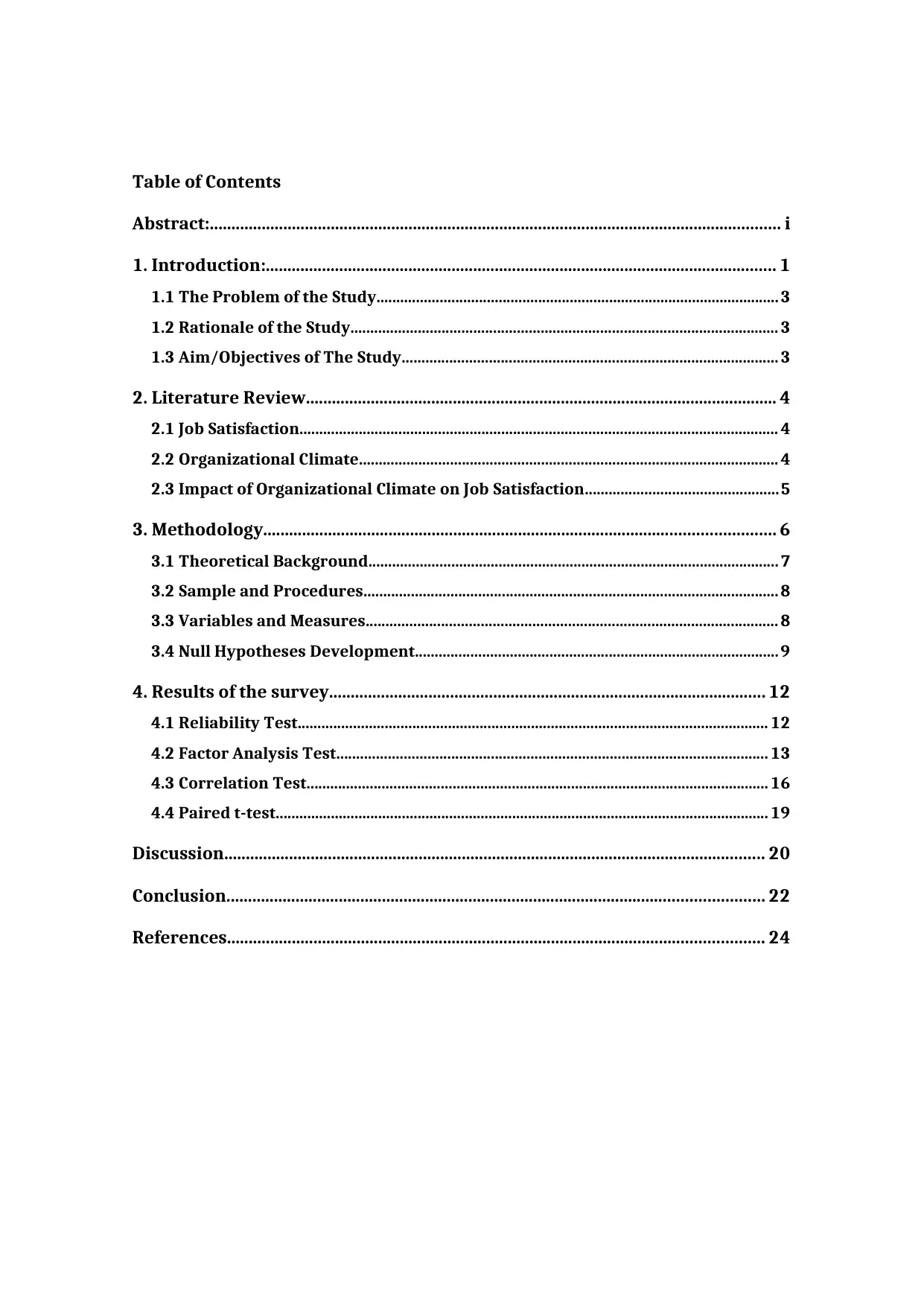
Table of Contents
Abstract:.................................................................................................................................... i
1. Introduction:...................................................................................................................... 1
1.1 The Problem of the Study......................................................................................................3
1.2 Rationale of the Study............................................................................................................ 3
1.3 Aim/Objectives of The Study............................................................................................... 3
2. Literature Review............................................................................................................. 4
2.1 Job Satisfaction......................................................................................................................... 4
2.2 Organizational Climate.......................................................................................................... 4
2.3 Impact of Organizational Climate on Job Satisfaction.................................................5
3. Methodology...................................................................................................................... 6
3.1 Theoretical Background........................................................................................................7
3.2 Sample and Procedures......................................................................................................... 8
3.3 Variables and Measures........................................................................................................ 8
3.4 Null Hypotheses Development............................................................................................9
4. Results of the survey..................................................................................................... 12
4.1 Reliability Test....................................................................................................................... 12
4.2 Factor Analysis Test............................................................................................................. 13
4.3 Correlation Test..................................................................................................................... 16
4.4 Paired t-test............................................................................................................................. 19
Discussion............................................................................................................................. 20
Conclusion............................................................................................................................ 22
References............................................................................................................................ 24
Abstract:.................................................................................................................................... i
1. Introduction:...................................................................................................................... 1
1.1 The Problem of the Study......................................................................................................3
1.2 Rationale of the Study............................................................................................................ 3
1.3 Aim/Objectives of The Study............................................................................................... 3
2. Literature Review............................................................................................................. 4
2.1 Job Satisfaction......................................................................................................................... 4
2.2 Organizational Climate.......................................................................................................... 4
2.3 Impact of Organizational Climate on Job Satisfaction.................................................5
3. Methodology...................................................................................................................... 6
3.1 Theoretical Background........................................................................................................7
3.2 Sample and Procedures......................................................................................................... 8
3.3 Variables and Measures........................................................................................................ 8
3.4 Null Hypotheses Development............................................................................................9
4. Results of the survey..................................................................................................... 12
4.1 Reliability Test....................................................................................................................... 12
4.2 Factor Analysis Test............................................................................................................. 13
4.3 Correlation Test..................................................................................................................... 16
4.4 Paired t-test............................................................................................................................. 19
Discussion............................................................................................................................. 20
Conclusion............................................................................................................................ 22
References............................................................................................................................ 24
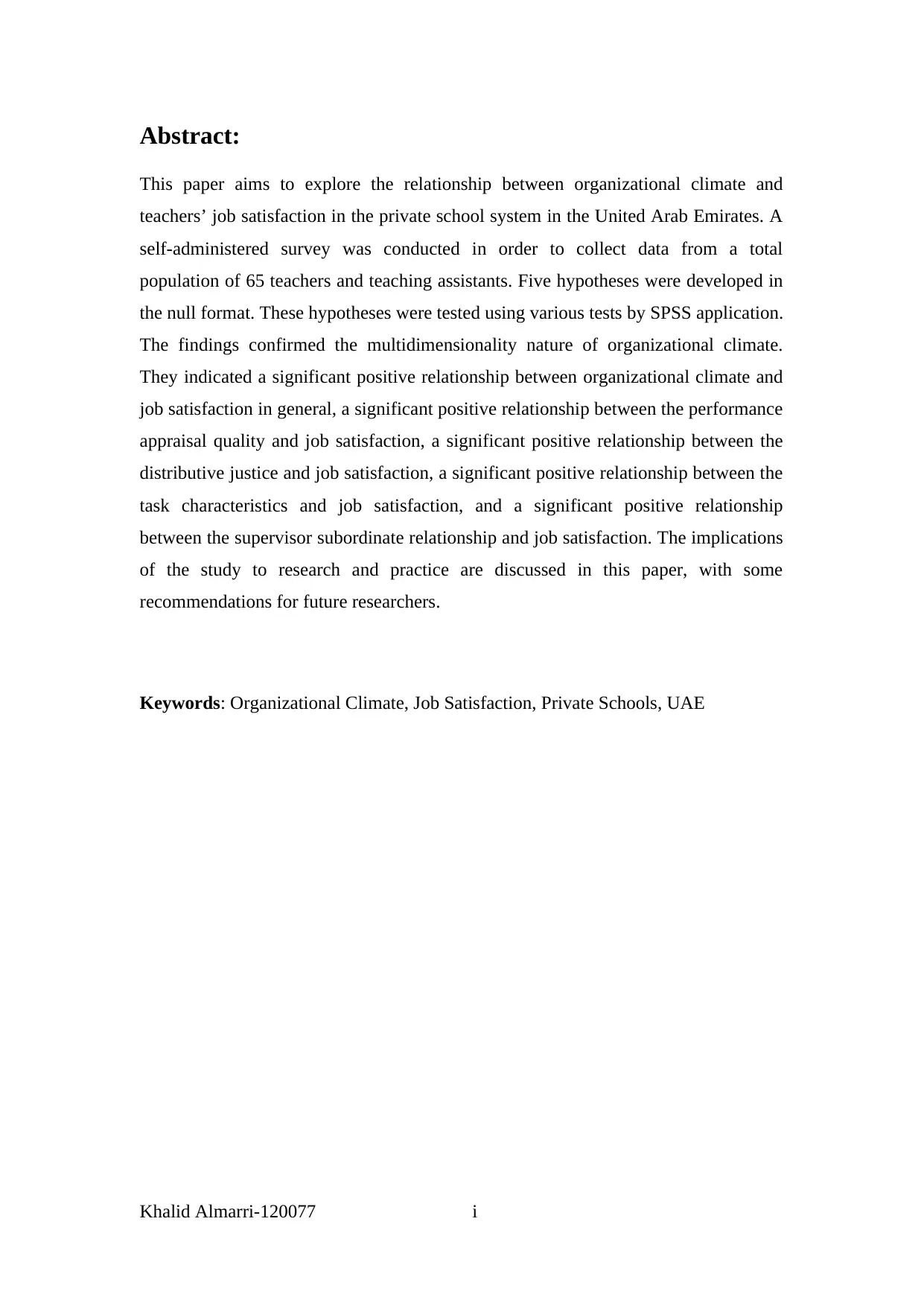
Abstract:
This paper aims to explore the relationship between organizational climate and
teachers’ job satisfaction in the private school system in the United Arab Emirates. A
self-administered survey was conducted in order to collect data from a total
population of 65 teachers and teaching assistants. Five hypotheses were developed in
the null format. These hypotheses were tested using various tests by SPSS application.
The findings confirmed the multidimensionality nature of organizational climate.
They indicated a significant positive relationship between organizational climate and
job satisfaction in general, a significant positive relationship between the performance
appraisal quality and job satisfaction, a significant positive relationship between the
distributive justice and job satisfaction, a significant positive relationship between the
task characteristics and job satisfaction, and a significant positive relationship
between the supervisor subordinate relationship and job satisfaction. The implications
of the study to research and practice are discussed in this paper, with some
recommendations for future researchers.
Keywords: Organizational Climate, Job Satisfaction, Private Schools, UAE
Khalid Almarri-120077 i
This paper aims to explore the relationship between organizational climate and
teachers’ job satisfaction in the private school system in the United Arab Emirates. A
self-administered survey was conducted in order to collect data from a total
population of 65 teachers and teaching assistants. Five hypotheses were developed in
the null format. These hypotheses were tested using various tests by SPSS application.
The findings confirmed the multidimensionality nature of organizational climate.
They indicated a significant positive relationship between organizational climate and
job satisfaction in general, a significant positive relationship between the performance
appraisal quality and job satisfaction, a significant positive relationship between the
distributive justice and job satisfaction, a significant positive relationship between the
task characteristics and job satisfaction, and a significant positive relationship
between the supervisor subordinate relationship and job satisfaction. The implications
of the study to research and practice are discussed in this paper, with some
recommendations for future researchers.
Keywords: Organizational Climate, Job Satisfaction, Private Schools, UAE
Khalid Almarri-120077 i
⊘ This is a preview!⊘
Do you want full access?
Subscribe today to unlock all pages.

Trusted by 1+ million students worldwide

1. Introduction:
Organizations that are looking to achieve their full potential and survive the fierce
competition require satisfied workers. The ability of any organization to maximize such
potential is dependent on its success in recruiting and retaining competent and satisfied
employees. The United Arab Emirates since the oil boom has become an attraction to a
mixed workforce from around the globe seeking opportunities to improve their income.
These communities of expatriates brought along with them rich experiences, talents, and
cultural traditions that enriched the local community. Some of these experiences are
evident in the educational and health sectors as there were very few schools and
hospitals in the UAE prior to the discovery of oil.
Education in the UAE is regarded as one of the strategic sectors in the country’s
economic plan approved by the president and supported by all sectors in the local
economy. This recognition came from the appreciation the country renders education as
the driving force behind the prosperity since the discovery of oil. The availability of
competent workforce is a constant concern of all organizations and therefore their
support for the economic plan to focus on education was unanimous. Educational
institutions are the incubators for future workforce that will feed the national growth. At
the same time, these educational institutions are organizations whose educational
product is affected by the level of satisfaction of their staff. Therefore, Sigma School is
continuously analysing the work context under which its teachers operate, to maximize
the level of their satisfaction, and subsequently the quality of educational services
rendered.
The management of the school promotes a healthy interaction among staff, and
implements a rigorous program that ensures continuous skills improvement, in addition
to an attractive incentive system that allows the employees of the school to, in some
cases, double their monthly salaries based on rewards related to their performance.
Despite the efforts by the management of Sigma School to satisfy staff, the teachers’
turnover has become a major concern in the past few years. The rate of turnover to rival
schools is very alarming taking into consideration the high cost the school incurs in the
wellbeing and the development of their teachers.
Khalid Almarri-120077 1
Organizations that are looking to achieve their full potential and survive the fierce
competition require satisfied workers. The ability of any organization to maximize such
potential is dependent on its success in recruiting and retaining competent and satisfied
employees. The United Arab Emirates since the oil boom has become an attraction to a
mixed workforce from around the globe seeking opportunities to improve their income.
These communities of expatriates brought along with them rich experiences, talents, and
cultural traditions that enriched the local community. Some of these experiences are
evident in the educational and health sectors as there were very few schools and
hospitals in the UAE prior to the discovery of oil.
Education in the UAE is regarded as one of the strategic sectors in the country’s
economic plan approved by the president and supported by all sectors in the local
economy. This recognition came from the appreciation the country renders education as
the driving force behind the prosperity since the discovery of oil. The availability of
competent workforce is a constant concern of all organizations and therefore their
support for the economic plan to focus on education was unanimous. Educational
institutions are the incubators for future workforce that will feed the national growth. At
the same time, these educational institutions are organizations whose educational
product is affected by the level of satisfaction of their staff. Therefore, Sigma School is
continuously analysing the work context under which its teachers operate, to maximize
the level of their satisfaction, and subsequently the quality of educational services
rendered.
The management of the school promotes a healthy interaction among staff, and
implements a rigorous program that ensures continuous skills improvement, in addition
to an attractive incentive system that allows the employees of the school to, in some
cases, double their monthly salaries based on rewards related to their performance.
Despite the efforts by the management of Sigma School to satisfy staff, the teachers’
turnover has become a major concern in the past few years. The rate of turnover to rival
schools is very alarming taking into consideration the high cost the school incurs in the
wellbeing and the development of their teachers.
Khalid Almarri-120077 1
Paraphrase This Document
Need a fresh take? Get an instant paraphrase of this document with our AI Paraphraser

Therefore, the school is looking to analyse its success in the efforts it makes in
providing the ideal working climate to satisfy its teachers, and consequently retain them.
Also, scholars in the field of human resources management are constantly looking to
analyse the relationship between organizational climate and job satisfaction to examine
the link between the variables, and to test if organizational climate can be a measure for
job satisfaction, and subsequently reduce turnover.
Educators face severe challenges in performing their duties, which may affect their job
satisfaction, which in turn will affect the organizational productivity (Adenike, 2011).
Organizational climate reflects the individual perceptions of employees about their
organization. The organizational climate as argued by Adenike (2011) consists of
“leadership styles, participation in decision making, provision of challenging jobs to
employees, reduction of frustration, provision of benefits, personnel policies, provision
of good working conditions and creation of suitable career ladder for academics”.
Whereas, job satisfaction is one of the most reliable variables used in research in
organizational behaviour. It is an attitudinal reaction to one’s organization (Sulaiman et
al., 2012). Sulaiman (2012) state that happy employees reflect their satisfaction in their
performance.
Although this study is inspired by the attrition and turnover phenomenon of teachers,
this work does not examine the attrition and turnover directly. The focus of this study is
to test the antecedents of attrition and turnover, particularly job satisfaction and the
motivation to leave the teaching job.
The purpose of this study is to examine the relationship between organizational climate
variables (Task Characteristics, Team Orientation, Motivations, Employee Competence,
Superior-subordinate Relationship, Involvement in Decision Making, Performance
Reward Relationship, Pressure to Produce, Psychological Contract, Distributive Justice,
Satisfaction with Appraisal), and teacher job satisfaction variables (Pay, Promotion
Opportunities, Supervisory Style, Co-workers Relations, Job-itself). The relationship
between organizational climate and teacher job satisfaction is important because
working conditions can be improved to enable better performance and subsequently
increase productivity and reduce turnover.
Khalid Almarri-120077 2
providing the ideal working climate to satisfy its teachers, and consequently retain them.
Also, scholars in the field of human resources management are constantly looking to
analyse the relationship between organizational climate and job satisfaction to examine
the link between the variables, and to test if organizational climate can be a measure for
job satisfaction, and subsequently reduce turnover.
Educators face severe challenges in performing their duties, which may affect their job
satisfaction, which in turn will affect the organizational productivity (Adenike, 2011).
Organizational climate reflects the individual perceptions of employees about their
organization. The organizational climate as argued by Adenike (2011) consists of
“leadership styles, participation in decision making, provision of challenging jobs to
employees, reduction of frustration, provision of benefits, personnel policies, provision
of good working conditions and creation of suitable career ladder for academics”.
Whereas, job satisfaction is one of the most reliable variables used in research in
organizational behaviour. It is an attitudinal reaction to one’s organization (Sulaiman et
al., 2012). Sulaiman (2012) state that happy employees reflect their satisfaction in their
performance.
Although this study is inspired by the attrition and turnover phenomenon of teachers,
this work does not examine the attrition and turnover directly. The focus of this study is
to test the antecedents of attrition and turnover, particularly job satisfaction and the
motivation to leave the teaching job.
The purpose of this study is to examine the relationship between organizational climate
variables (Task Characteristics, Team Orientation, Motivations, Employee Competence,
Superior-subordinate Relationship, Involvement in Decision Making, Performance
Reward Relationship, Pressure to Produce, Psychological Contract, Distributive Justice,
Satisfaction with Appraisal), and teacher job satisfaction variables (Pay, Promotion
Opportunities, Supervisory Style, Co-workers Relations, Job-itself). The relationship
between organizational climate and teacher job satisfaction is important because
working conditions can be improved to enable better performance and subsequently
increase productivity and reduce turnover.
Khalid Almarri-120077 2
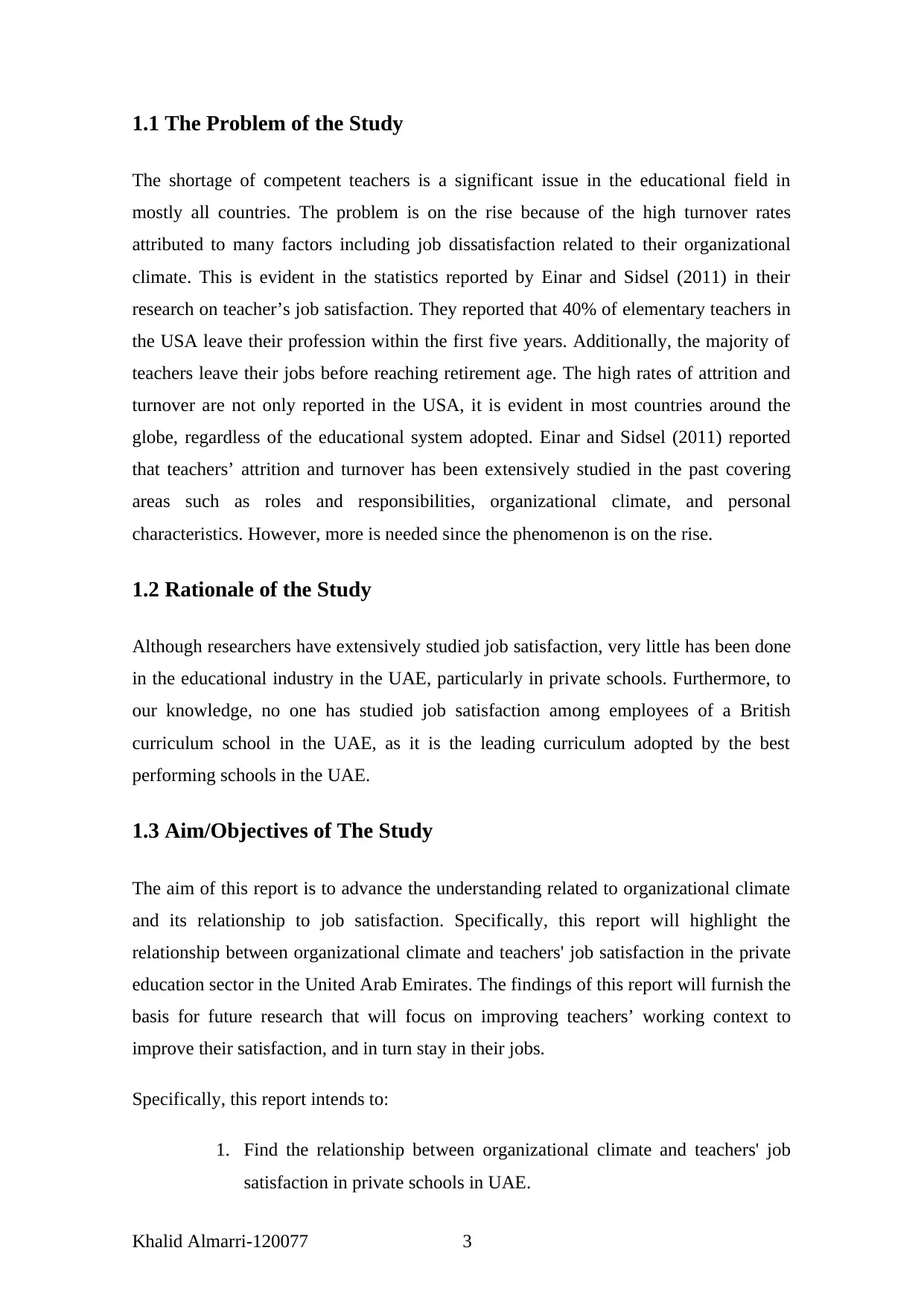
1.1 The Problem of the Study
The shortage of competent teachers is a significant issue in the educational field in
mostly all countries. The problem is on the rise because of the high turnover rates
attributed to many factors including job dissatisfaction related to their organizational
climate. This is evident in the statistics reported by Einar and Sidsel (2011) in their
research on teacher’s job satisfaction. They reported that 40% of elementary teachers in
the USA leave their profession within the first five years. Additionally, the majority of
teachers leave their jobs before reaching retirement age. The high rates of attrition and
turnover are not only reported in the USA, it is evident in most countries around the
globe, regardless of the educational system adopted. Einar and Sidsel (2011) reported
that teachers’ attrition and turnover has been extensively studied in the past covering
areas such as roles and responsibilities, organizational climate, and personal
characteristics. However, more is needed since the phenomenon is on the rise.
1.2 Rationale of the Study
Although researchers have extensively studied job satisfaction, very little has been done
in the educational industry in the UAE, particularly in private schools. Furthermore, to
our knowledge, no one has studied job satisfaction among employees of a British
curriculum school in the UAE, as it is the leading curriculum adopted by the best
performing schools in the UAE.
1.3 Aim/Objectives of The Study
The aim of this report is to advance the understanding related to organizational climate
and its relationship to job satisfaction. Specifically, this report will highlight the
relationship between organizational climate and teachers' job satisfaction in the private
education sector in the United Arab Emirates. The findings of this report will furnish the
basis for future research that will focus on improving teachers’ working context to
improve their satisfaction, and in turn stay in their jobs.
Specifically, this report intends to:
1. Find the relationship between organizational climate and teachers' job
satisfaction in private schools in UAE.
Khalid Almarri-120077 3
The shortage of competent teachers is a significant issue in the educational field in
mostly all countries. The problem is on the rise because of the high turnover rates
attributed to many factors including job dissatisfaction related to their organizational
climate. This is evident in the statistics reported by Einar and Sidsel (2011) in their
research on teacher’s job satisfaction. They reported that 40% of elementary teachers in
the USA leave their profession within the first five years. Additionally, the majority of
teachers leave their jobs before reaching retirement age. The high rates of attrition and
turnover are not only reported in the USA, it is evident in most countries around the
globe, regardless of the educational system adopted. Einar and Sidsel (2011) reported
that teachers’ attrition and turnover has been extensively studied in the past covering
areas such as roles and responsibilities, organizational climate, and personal
characteristics. However, more is needed since the phenomenon is on the rise.
1.2 Rationale of the Study
Although researchers have extensively studied job satisfaction, very little has been done
in the educational industry in the UAE, particularly in private schools. Furthermore, to
our knowledge, no one has studied job satisfaction among employees of a British
curriculum school in the UAE, as it is the leading curriculum adopted by the best
performing schools in the UAE.
1.3 Aim/Objectives of The Study
The aim of this report is to advance the understanding related to organizational climate
and its relationship to job satisfaction. Specifically, this report will highlight the
relationship between organizational climate and teachers' job satisfaction in the private
education sector in the United Arab Emirates. The findings of this report will furnish the
basis for future research that will focus on improving teachers’ working context to
improve their satisfaction, and in turn stay in their jobs.
Specifically, this report intends to:
1. Find the relationship between organizational climate and teachers' job
satisfaction in private schools in UAE.
Khalid Almarri-120077 3
⊘ This is a preview!⊘
Do you want full access?
Subscribe today to unlock all pages.

Trusted by 1+ million students worldwide
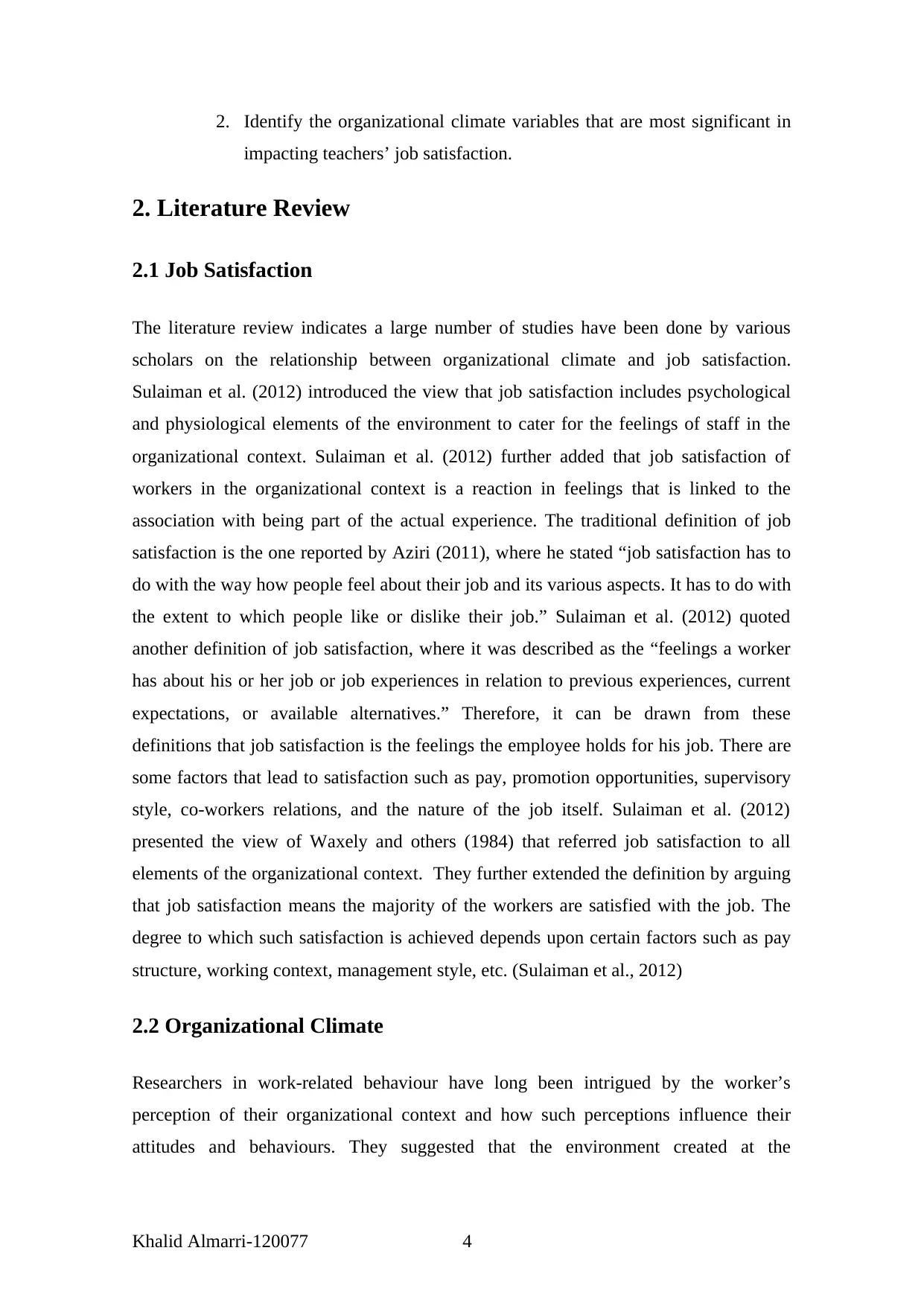
2. Identify the organizational climate variables that are most significant in
impacting teachers’ job satisfaction.
2. Literature Review
2.1 Job Satisfaction
The literature review indicates a large number of studies have been done by various
scholars on the relationship between organizational climate and job satisfaction.
Sulaiman et al. (2012) introduced the view that job satisfaction includes psychological
and physiological elements of the environment to cater for the feelings of staff in the
organizational context. Sulaiman et al. (2012) further added that job satisfaction of
workers in the organizational context is a reaction in feelings that is linked to the
association with being part of the actual experience. The traditional definition of job
satisfaction is the one reported by Aziri (2011), where he stated “job satisfaction has to
do with the way how people feel about their job and its various aspects. It has to do with
the extent to which people like or dislike their job.” Sulaiman et al. (2012) quoted
another definition of job satisfaction, where it was described as the “feelings a worker
has about his or her job or job experiences in relation to previous experiences, current
expectations, or available alternatives.” Therefore, it can be drawn from these
definitions that job satisfaction is the feelings the employee holds for his job. There are
some factors that lead to satisfaction such as pay, promotion opportunities, supervisory
style, co-workers relations, and the nature of the job itself. Sulaiman et al. (2012)
presented the view of Waxely and others (1984) that referred job satisfaction to all
elements of the organizational context. They further extended the definition by arguing
that job satisfaction means the majority of the workers are satisfied with the job. The
degree to which such satisfaction is achieved depends upon certain factors such as pay
structure, working context, management style, etc. (Sulaiman et al., 2012)
2.2 Organizational Climate
Researchers in work-related behaviour have long been intrigued by the worker’s
perception of their organizational context and how such perceptions influence their
attitudes and behaviours. They suggested that the environment created at the
Khalid Almarri-120077 4
impacting teachers’ job satisfaction.
2. Literature Review
2.1 Job Satisfaction
The literature review indicates a large number of studies have been done by various
scholars on the relationship between organizational climate and job satisfaction.
Sulaiman et al. (2012) introduced the view that job satisfaction includes psychological
and physiological elements of the environment to cater for the feelings of staff in the
organizational context. Sulaiman et al. (2012) further added that job satisfaction of
workers in the organizational context is a reaction in feelings that is linked to the
association with being part of the actual experience. The traditional definition of job
satisfaction is the one reported by Aziri (2011), where he stated “job satisfaction has to
do with the way how people feel about their job and its various aspects. It has to do with
the extent to which people like or dislike their job.” Sulaiman et al. (2012) quoted
another definition of job satisfaction, where it was described as the “feelings a worker
has about his or her job or job experiences in relation to previous experiences, current
expectations, or available alternatives.” Therefore, it can be drawn from these
definitions that job satisfaction is the feelings the employee holds for his job. There are
some factors that lead to satisfaction such as pay, promotion opportunities, supervisory
style, co-workers relations, and the nature of the job itself. Sulaiman et al. (2012)
presented the view of Waxely and others (1984) that referred job satisfaction to all
elements of the organizational context. They further extended the definition by arguing
that job satisfaction means the majority of the workers are satisfied with the job. The
degree to which such satisfaction is achieved depends upon certain factors such as pay
structure, working context, management style, etc. (Sulaiman et al., 2012)
2.2 Organizational Climate
Researchers in work-related behaviour have long been intrigued by the worker’s
perception of their organizational context and how such perceptions influence their
attitudes and behaviours. They suggested that the environment created at the
Khalid Almarri-120077 4
Paraphrase This Document
Need a fresh take? Get an instant paraphrase of this document with our AI Paraphraser
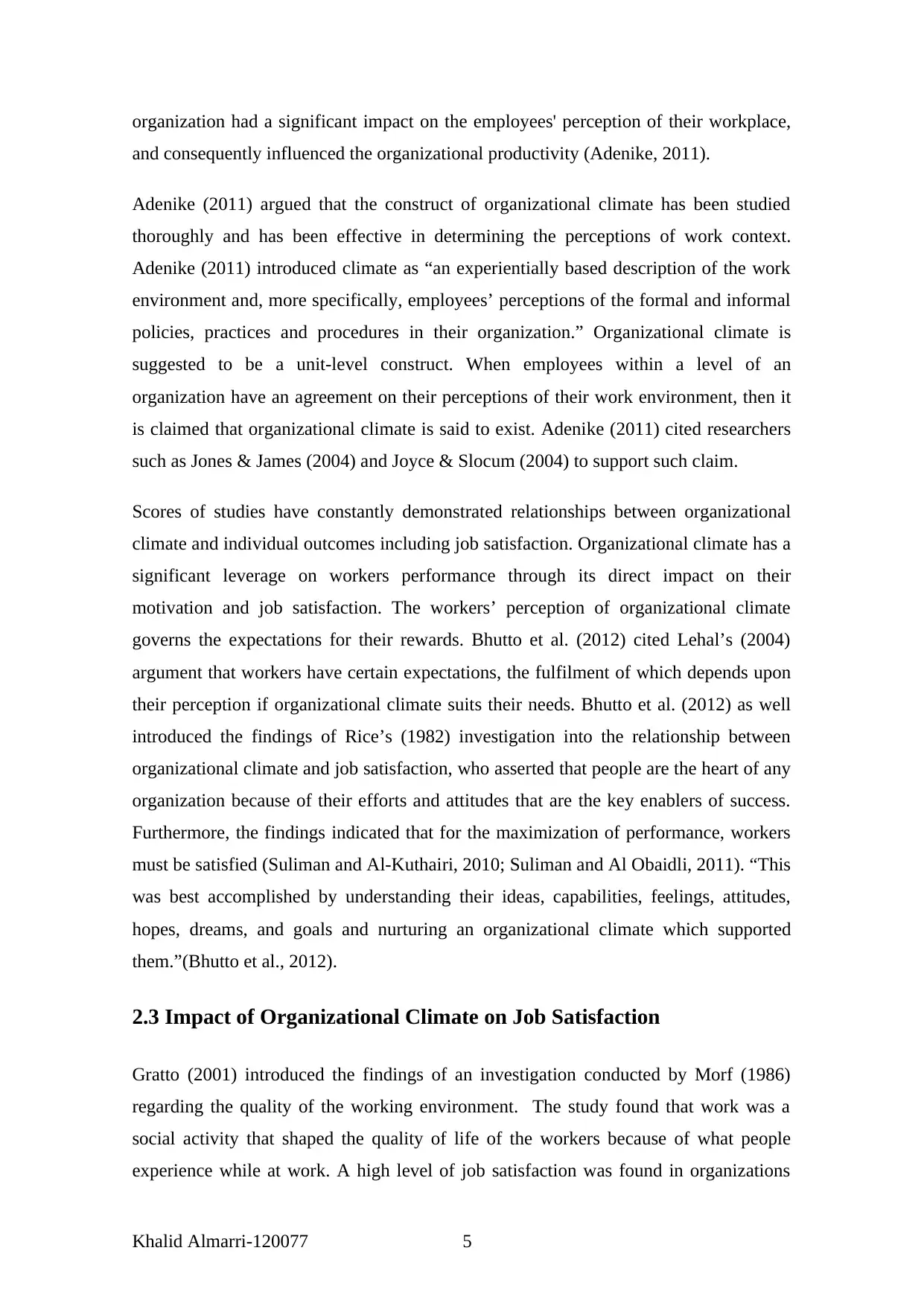
organization had a significant impact on the employees' perception of their workplace,
and consequently influenced the organizational productivity (Adenike, 2011).
Adenike (2011) argued that the construct of organizational climate has been studied
thoroughly and has been effective in determining the perceptions of work context.
Adenike (2011) introduced climate as “an experientially based description of the work
environment and, more specifically, employees’ perceptions of the formal and informal
policies, practices and procedures in their organization.” Organizational climate is
suggested to be a unit-level construct. When employees within a level of an
organization have an agreement on their perceptions of their work environment, then it
is claimed that organizational climate is said to exist. Adenike (2011) cited researchers
such as Jones & James (2004) and Joyce & Slocum (2004) to support such claim.
Scores of studies have constantly demonstrated relationships between organizational
climate and individual outcomes including job satisfaction. Organizational climate has a
significant leverage on workers performance through its direct impact on their
motivation and job satisfaction. The workers’ perception of organizational climate
governs the expectations for their rewards. Bhutto et al. (2012) cited Lehal’s (2004)
argument that workers have certain expectations, the fulfilment of which depends upon
their perception if organizational climate suits their needs. Bhutto et al. (2012) as well
introduced the findings of Rice’s (1982) investigation into the relationship between
organizational climate and job satisfaction, who asserted that people are the heart of any
organization because of their efforts and attitudes that are the key enablers of success.
Furthermore, the findings indicated that for the maximization of performance, workers
must be satisfied (Suliman and Al-Kuthairi, 2010; Suliman and Al Obaidli, 2011). “This
was best accomplished by understanding their ideas, capabilities, feelings, attitudes,
hopes, dreams, and goals and nurturing an organizational climate which supported
them.”(Bhutto et al., 2012).
2.3 Impact of Organizational Climate on Job Satisfaction
Gratto (2001) introduced the findings of an investigation conducted by Morf (1986)
regarding the quality of the working environment. The study found that work was a
social activity that shaped the quality of life of the workers because of what people
experience while at work. A high level of job satisfaction was found in organizations
Khalid Almarri-120077 5
and consequently influenced the organizational productivity (Adenike, 2011).
Adenike (2011) argued that the construct of organizational climate has been studied
thoroughly and has been effective in determining the perceptions of work context.
Adenike (2011) introduced climate as “an experientially based description of the work
environment and, more specifically, employees’ perceptions of the formal and informal
policies, practices and procedures in their organization.” Organizational climate is
suggested to be a unit-level construct. When employees within a level of an
organization have an agreement on their perceptions of their work environment, then it
is claimed that organizational climate is said to exist. Adenike (2011) cited researchers
such as Jones & James (2004) and Joyce & Slocum (2004) to support such claim.
Scores of studies have constantly demonstrated relationships between organizational
climate and individual outcomes including job satisfaction. Organizational climate has a
significant leverage on workers performance through its direct impact on their
motivation and job satisfaction. The workers’ perception of organizational climate
governs the expectations for their rewards. Bhutto et al. (2012) cited Lehal’s (2004)
argument that workers have certain expectations, the fulfilment of which depends upon
their perception if organizational climate suits their needs. Bhutto et al. (2012) as well
introduced the findings of Rice’s (1982) investigation into the relationship between
organizational climate and job satisfaction, who asserted that people are the heart of any
organization because of their efforts and attitudes that are the key enablers of success.
Furthermore, the findings indicated that for the maximization of performance, workers
must be satisfied (Suliman and Al-Kuthairi, 2010; Suliman and Al Obaidli, 2011). “This
was best accomplished by understanding their ideas, capabilities, feelings, attitudes,
hopes, dreams, and goals and nurturing an organizational climate which supported
them.”(Bhutto et al., 2012).
2.3 Impact of Organizational Climate on Job Satisfaction
Gratto (2001) introduced the findings of an investigation conducted by Morf (1986)
regarding the quality of the working environment. The study found that work was a
social activity that shaped the quality of life of the workers because of what people
experience while at work. A high level of job satisfaction was found in organizations
Khalid Almarri-120077 5
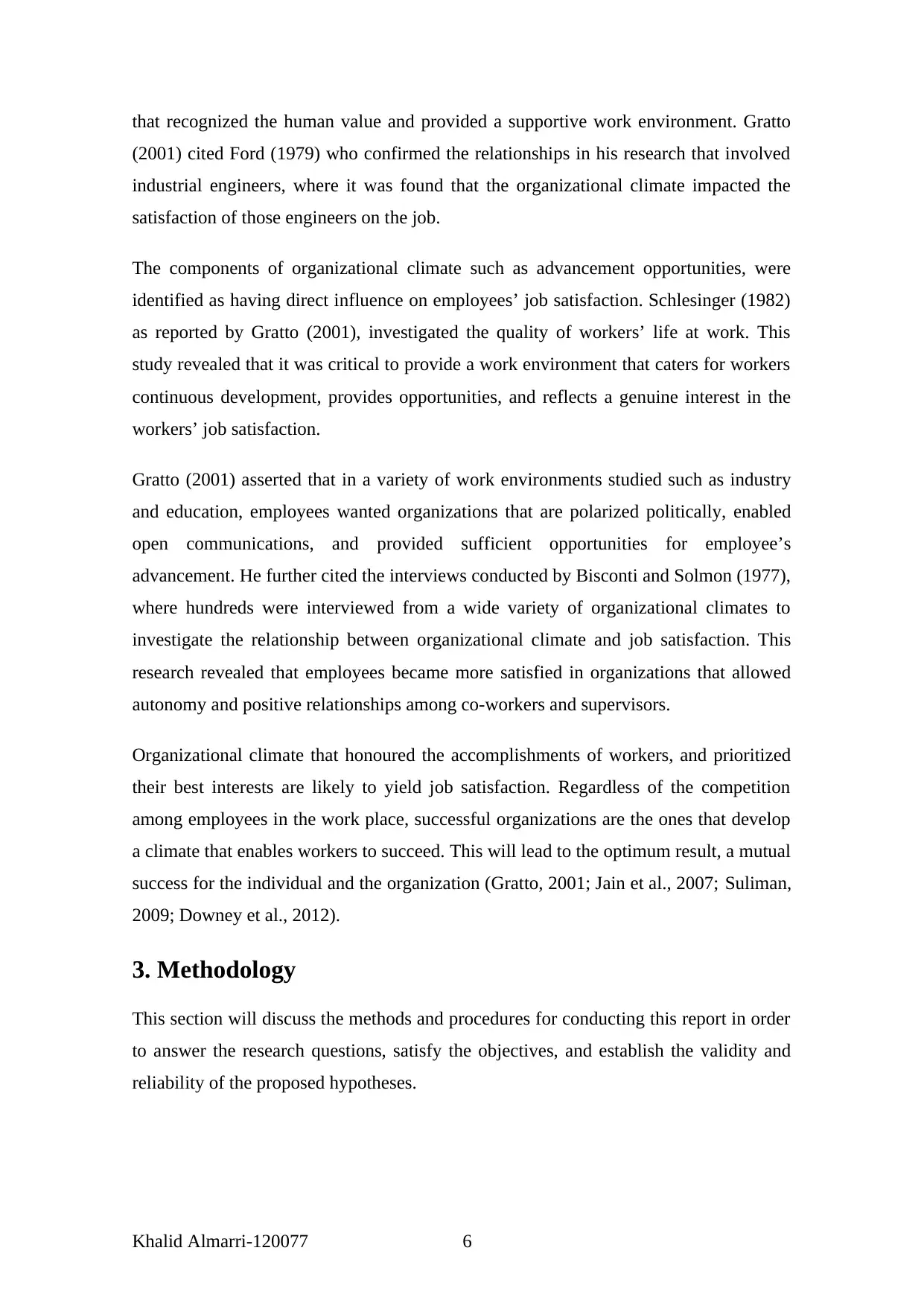
that recognized the human value and provided a supportive work environment. Gratto
(2001) cited Ford (1979) who confirmed the relationships in his research that involved
industrial engineers, where it was found that the organizational climate impacted the
satisfaction of those engineers on the job.
The components of organizational climate such as advancement opportunities, were
identified as having direct influence on employees’ job satisfaction. Schlesinger (1982)
as reported by Gratto (2001), investigated the quality of workers’ life at work. This
study revealed that it was critical to provide a work environment that caters for workers
continuous development, provides opportunities, and reflects a genuine interest in the
workers’ job satisfaction.
Gratto (2001) asserted that in a variety of work environments studied such as industry
and education, employees wanted organizations that are polarized politically, enabled
open communications, and provided sufficient opportunities for employee’s
advancement. He further cited the interviews conducted by Bisconti and Solmon (1977),
where hundreds were interviewed from a wide variety of organizational climates to
investigate the relationship between organizational climate and job satisfaction. This
research revealed that employees became more satisfied in organizations that allowed
autonomy and positive relationships among co-workers and supervisors.
Organizational climate that honoured the accomplishments of workers, and prioritized
their best interests are likely to yield job satisfaction. Regardless of the competition
among employees in the work place, successful organizations are the ones that develop
a climate that enables workers to succeed. This will lead to the optimum result, a mutual
success for the individual and the organization (Gratto, 2001; Jain et al., 2007; Suliman,
2009; Downey et al., 2012).
3. Methodology
This section will discuss the methods and procedures for conducting this report in order
to answer the research questions, satisfy the objectives, and establish the validity and
reliability of the proposed hypotheses.
Khalid Almarri-120077 6
(2001) cited Ford (1979) who confirmed the relationships in his research that involved
industrial engineers, where it was found that the organizational climate impacted the
satisfaction of those engineers on the job.
The components of organizational climate such as advancement opportunities, were
identified as having direct influence on employees’ job satisfaction. Schlesinger (1982)
as reported by Gratto (2001), investigated the quality of workers’ life at work. This
study revealed that it was critical to provide a work environment that caters for workers
continuous development, provides opportunities, and reflects a genuine interest in the
workers’ job satisfaction.
Gratto (2001) asserted that in a variety of work environments studied such as industry
and education, employees wanted organizations that are polarized politically, enabled
open communications, and provided sufficient opportunities for employee’s
advancement. He further cited the interviews conducted by Bisconti and Solmon (1977),
where hundreds were interviewed from a wide variety of organizational climates to
investigate the relationship between organizational climate and job satisfaction. This
research revealed that employees became more satisfied in organizations that allowed
autonomy and positive relationships among co-workers and supervisors.
Organizational climate that honoured the accomplishments of workers, and prioritized
their best interests are likely to yield job satisfaction. Regardless of the competition
among employees in the work place, successful organizations are the ones that develop
a climate that enables workers to succeed. This will lead to the optimum result, a mutual
success for the individual and the organization (Gratto, 2001; Jain et al., 2007; Suliman,
2009; Downey et al., 2012).
3. Methodology
This section will discuss the methods and procedures for conducting this report in order
to answer the research questions, satisfy the objectives, and establish the validity and
reliability of the proposed hypotheses.
Khalid Almarri-120077 6
⊘ This is a preview!⊘
Do you want full access?
Subscribe today to unlock all pages.

Trusted by 1+ million students worldwide
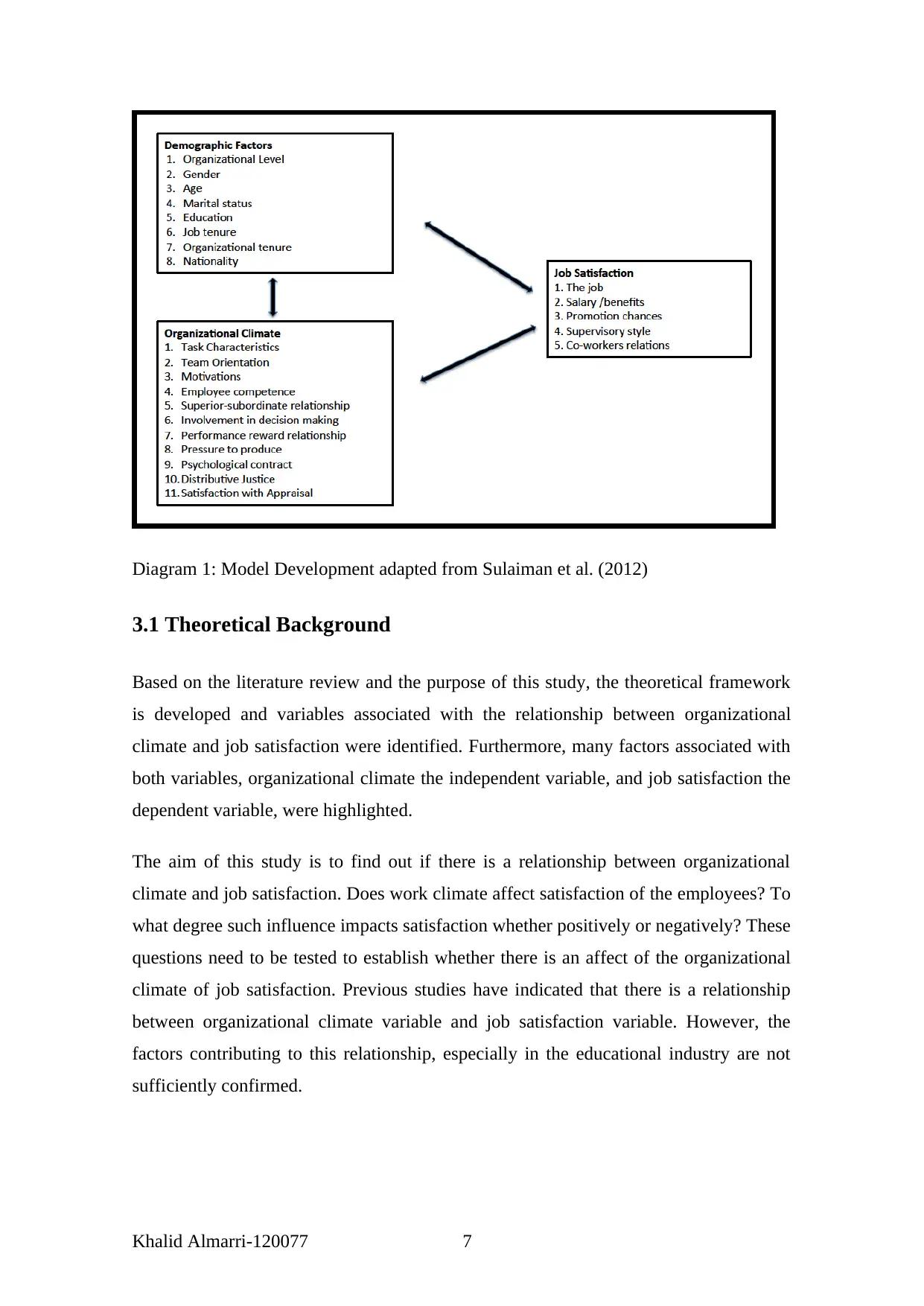
Diagram 1: Model Development adapted from Sulaiman et al. (2012)
3.1 Theoretical Background
Based on the literature review and the purpose of this study, the theoretical framework
is developed and variables associated with the relationship between organizational
climate and job satisfaction were identified. Furthermore, many factors associated with
both variables, organizational climate the independent variable, and job satisfaction the
dependent variable, were highlighted.
The aim of this study is to find out if there is a relationship between organizational
climate and job satisfaction. Does work climate affect satisfaction of the employees? To
what degree such influence impacts satisfaction whether positively or negatively? These
questions need to be tested to establish whether there is an affect of the organizational
climate of job satisfaction. Previous studies have indicated that there is a relationship
between organizational climate variable and job satisfaction variable. However, the
factors contributing to this relationship, especially in the educational industry are not
sufficiently confirmed.
Khalid Almarri-120077 7
3.1 Theoretical Background
Based on the literature review and the purpose of this study, the theoretical framework
is developed and variables associated with the relationship between organizational
climate and job satisfaction were identified. Furthermore, many factors associated with
both variables, organizational climate the independent variable, and job satisfaction the
dependent variable, were highlighted.
The aim of this study is to find out if there is a relationship between organizational
climate and job satisfaction. Does work climate affect satisfaction of the employees? To
what degree such influence impacts satisfaction whether positively or negatively? These
questions need to be tested to establish whether there is an affect of the organizational
climate of job satisfaction. Previous studies have indicated that there is a relationship
between organizational climate variable and job satisfaction variable. However, the
factors contributing to this relationship, especially in the educational industry are not
sufficiently confirmed.
Khalid Almarri-120077 7
Paraphrase This Document
Need a fresh take? Get an instant paraphrase of this document with our AI Paraphraser
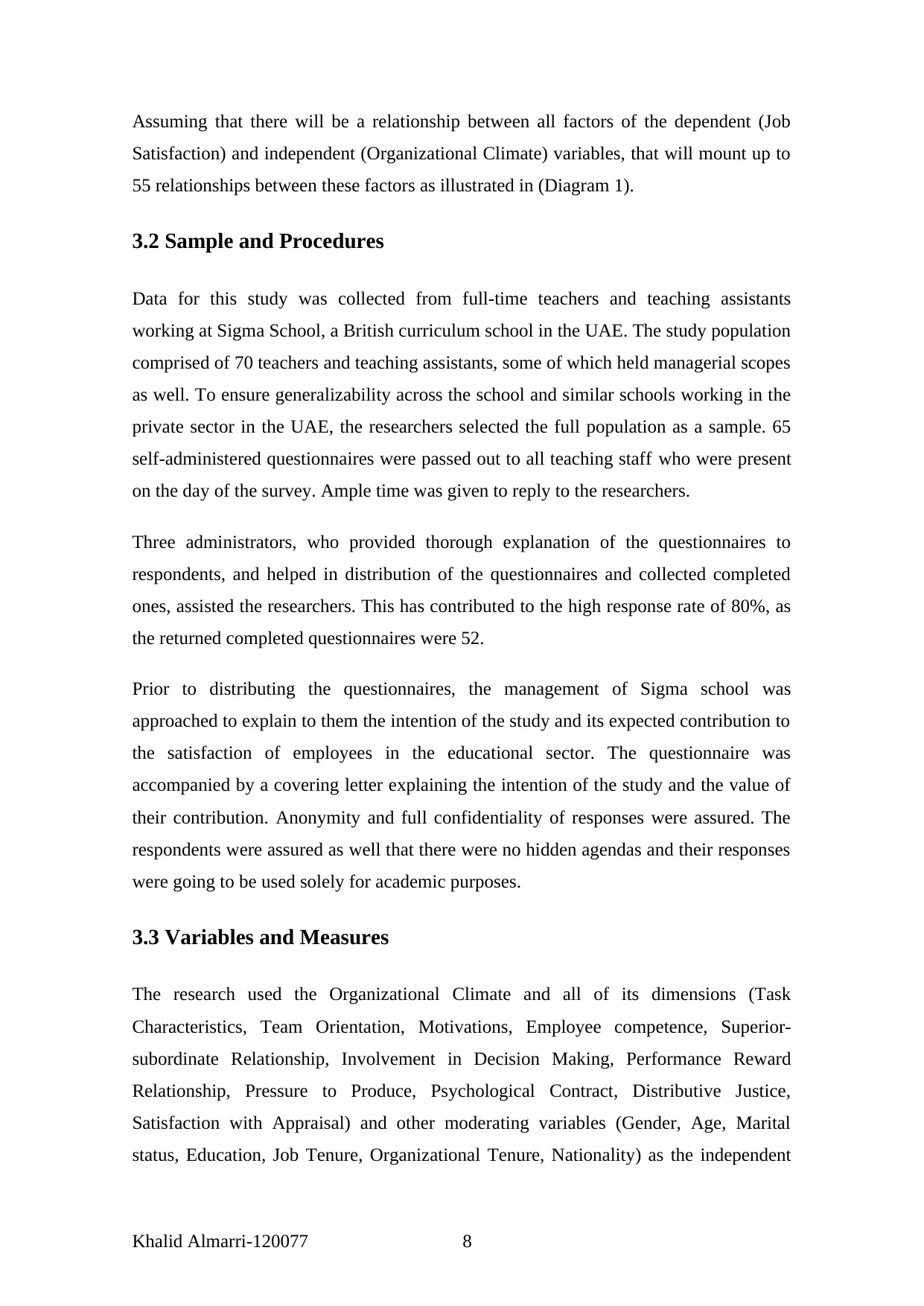
Assuming that there will be a relationship between all factors of the dependent (Job
Satisfaction) and independent (Organizational Climate) variables, that will mount up to
55 relationships between these factors as illustrated in (Diagram 1).
3.2 Sample and Procedures
Data for this study was collected from full-time teachers and teaching assistants
working at Sigma School, a British curriculum school in the UAE. The study population
comprised of 70 teachers and teaching assistants, some of which held managerial scopes
as well. To ensure generalizability across the school and similar schools working in the
private sector in the UAE, the researchers selected the full population as a sample. 65
self-administered questionnaires were passed out to all teaching staff who were present
on the day of the survey. Ample time was given to reply to the researchers.
Three administrators, who provided thorough explanation of the questionnaires to
respondents, and helped in distribution of the questionnaires and collected completed
ones, assisted the researchers. This has contributed to the high response rate of 80%, as
the returned completed questionnaires were 52.
Prior to distributing the questionnaires, the management of Sigma school was
approached to explain to them the intention of the study and its expected contribution to
the satisfaction of employees in the educational sector. The questionnaire was
accompanied by a covering letter explaining the intention of the study and the value of
their contribution. Anonymity and full confidentiality of responses were assured. The
respondents were assured as well that there were no hidden agendas and their responses
were going to be used solely for academic purposes.
3.3 Variables and Measures
The research used the Organizational Climate and all of its dimensions (Task
Characteristics, Team Orientation, Motivations, Employee competence, Superior-
subordinate Relationship, Involvement in Decision Making, Performance Reward
Relationship, Pressure to Produce, Psychological Contract, Distributive Justice,
Satisfaction with Appraisal) and other moderating variables (Gender, Age, Marital
status, Education, Job Tenure, Organizational Tenure, Nationality) as the independent
Khalid Almarri-120077 8
Satisfaction) and independent (Organizational Climate) variables, that will mount up to
55 relationships between these factors as illustrated in (Diagram 1).
3.2 Sample and Procedures
Data for this study was collected from full-time teachers and teaching assistants
working at Sigma School, a British curriculum school in the UAE. The study population
comprised of 70 teachers and teaching assistants, some of which held managerial scopes
as well. To ensure generalizability across the school and similar schools working in the
private sector in the UAE, the researchers selected the full population as a sample. 65
self-administered questionnaires were passed out to all teaching staff who were present
on the day of the survey. Ample time was given to reply to the researchers.
Three administrators, who provided thorough explanation of the questionnaires to
respondents, and helped in distribution of the questionnaires and collected completed
ones, assisted the researchers. This has contributed to the high response rate of 80%, as
the returned completed questionnaires were 52.
Prior to distributing the questionnaires, the management of Sigma school was
approached to explain to them the intention of the study and its expected contribution to
the satisfaction of employees in the educational sector. The questionnaire was
accompanied by a covering letter explaining the intention of the study and the value of
their contribution. Anonymity and full confidentiality of responses were assured. The
respondents were assured as well that there were no hidden agendas and their responses
were going to be used solely for academic purposes.
3.3 Variables and Measures
The research used the Organizational Climate and all of its dimensions (Task
Characteristics, Team Orientation, Motivations, Employee competence, Superior-
subordinate Relationship, Involvement in Decision Making, Performance Reward
Relationship, Pressure to Produce, Psychological Contract, Distributive Justice,
Satisfaction with Appraisal) and other moderating variables (Gender, Age, Marital
status, Education, Job Tenure, Organizational Tenure, Nationality) as the independent
Khalid Almarri-120077 8
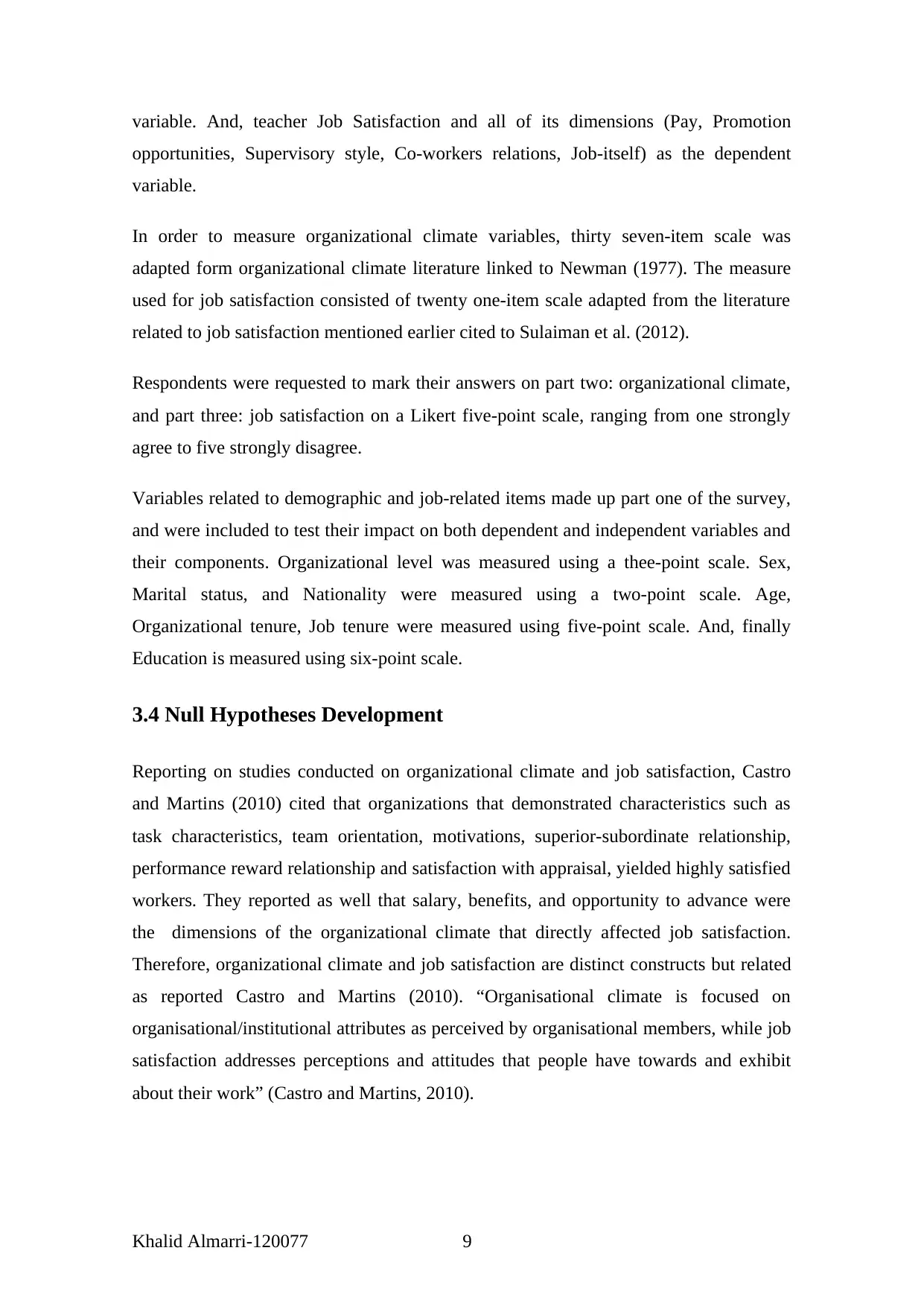
variable. And, teacher Job Satisfaction and all of its dimensions (Pay, Promotion
opportunities, Supervisory style, Co-workers relations, Job-itself) as the dependent
variable.
In order to measure organizational climate variables, thirty seven-item scale was
adapted form organizational climate literature linked to Newman (1977). The measure
used for job satisfaction consisted of twenty one-item scale adapted from the literature
related to job satisfaction mentioned earlier cited to Sulaiman et al. (2012).
Respondents were requested to mark their answers on part two: organizational climate,
and part three: job satisfaction on a Likert five-point scale, ranging from one strongly
agree to five strongly disagree.
Variables related to demographic and job-related items made up part one of the survey,
and were included to test their impact on both dependent and independent variables and
their components. Organizational level was measured using a thee-point scale. Sex,
Marital status, and Nationality were measured using a two-point scale. Age,
Organizational tenure, Job tenure were measured using five-point scale. And, finally
Education is measured using six-point scale.
3.4 Null Hypotheses Development
Reporting on studies conducted on organizational climate and job satisfaction, Castro
and Martins (2010) cited that organizations that demonstrated characteristics such as
task characteristics, team orientation, motivations, superior-subordinate relationship,
performance reward relationship and satisfaction with appraisal, yielded highly satisfied
workers. They reported as well that salary, benefits, and opportunity to advance were
the dimensions of the organizational climate that directly affected job satisfaction.
Therefore, organizational climate and job satisfaction are distinct constructs but related
as reported Castro and Martins (2010). “Organisational climate is focused on
organisational/institutional attributes as perceived by organisational members, while job
satisfaction addresses perceptions and attitudes that people have towards and exhibit
about their work” (Castro and Martins, 2010).
Khalid Almarri-120077 9
opportunities, Supervisory style, Co-workers relations, Job-itself) as the dependent
variable.
In order to measure organizational climate variables, thirty seven-item scale was
adapted form organizational climate literature linked to Newman (1977). The measure
used for job satisfaction consisted of twenty one-item scale adapted from the literature
related to job satisfaction mentioned earlier cited to Sulaiman et al. (2012).
Respondents were requested to mark their answers on part two: organizational climate,
and part three: job satisfaction on a Likert five-point scale, ranging from one strongly
agree to five strongly disagree.
Variables related to demographic and job-related items made up part one of the survey,
and were included to test their impact on both dependent and independent variables and
their components. Organizational level was measured using a thee-point scale. Sex,
Marital status, and Nationality were measured using a two-point scale. Age,
Organizational tenure, Job tenure were measured using five-point scale. And, finally
Education is measured using six-point scale.
3.4 Null Hypotheses Development
Reporting on studies conducted on organizational climate and job satisfaction, Castro
and Martins (2010) cited that organizations that demonstrated characteristics such as
task characteristics, team orientation, motivations, superior-subordinate relationship,
performance reward relationship and satisfaction with appraisal, yielded highly satisfied
workers. They reported as well that salary, benefits, and opportunity to advance were
the dimensions of the organizational climate that directly affected job satisfaction.
Therefore, organizational climate and job satisfaction are distinct constructs but related
as reported Castro and Martins (2010). “Organisational climate is focused on
organisational/institutional attributes as perceived by organisational members, while job
satisfaction addresses perceptions and attitudes that people have towards and exhibit
about their work” (Castro and Martins, 2010).
Khalid Almarri-120077 9
⊘ This is a preview!⊘
Do you want full access?
Subscribe today to unlock all pages.

Trusted by 1+ million students worldwide
1 out of 29
Related Documents
Your All-in-One AI-Powered Toolkit for Academic Success.
+13062052269
info@desklib.com
Available 24*7 on WhatsApp / Email
![[object Object]](/_next/static/media/star-bottom.7253800d.svg)
Unlock your academic potential
Copyright © 2020–2025 A2Z Services. All Rights Reserved. Developed and managed by ZUCOL.





